Steeplechase Racing Terms: Your Guide to Sounding Like a Pro at the Races
What do steeplechase racing terms mean, and why do they matter? If you’re heading to the Steeplechase of Charleston on November 9, 2025 and want to sound like you know your stuff, understanding the language of horse racing makes the experience more enjoyable. Whether this is your first steeplechase or you just want to brush up before race day, knowing a few key terms helps you follow the action like a seasoned racing fan.
Before the Race
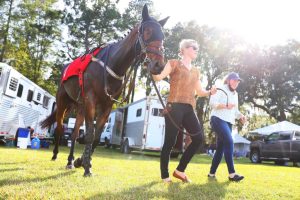 The Paddock – The area where horses gather before each race. At Steeplechase of Charleston, the paddock is sponsored by Huntington Bank. Spectators can get up close to see the horses, watch jockeys mount up, and assess which competitors look ready to run. Arrive about 20 minutes before each race for the best viewing.
The Paddock – The area where horses gather before each race. At Steeplechase of Charleston, the paddock is sponsored by Huntington Bank. Spectators can get up close to see the horses, watch jockeys mount up, and assess which competitors look ready to run. Arrive about 20 minutes before each race for the best viewing.
Best Turned Out – The award for the horse and Groom that looks the most polished and well-groomed in the paddock. This isn’t about speed—it’s about presentation and the connection between groom and horse.
Racing Silks – The colorful uniforms jockeys wear. Each pattern is unique to the horse’s owner and registered so no two are alike. When someone says “the green and gold silks,” they’re identifying a specific horse by its owner’s colors.
 Riders Up – The call that signals jockeys to mount their horses in the paddock. When you hear “Riders up!” it means the race is about to begin and it’s time for jockeys to get on. This is one of those classic racing moments that gives everyone goosebumps.
Riders Up – The call that signals jockeys to mount their horses in the paddock. When you hear “Riders up!” it means the race is about to begin and it’s time for jockeys to get on. This is one of those classic racing moments that gives everyone goosebumps.
Post Position – Where each horse starts the race. Lower numbers mean closer to the inside rail, which can be an advantage or disadvantage depending on the course.
The Field – All the horses competing in a single race. Someone might say “it’s a strong field today” meaning the competition is tight.
During the Race
Going – The track condition. “Good going” means firm, dry ground while “soft going” or “heavy going” means the track is wet or muddy, which affects speed and strategy.
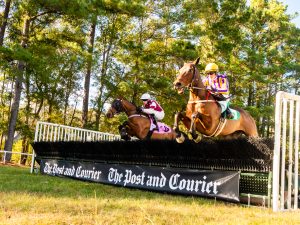
Chase – Short for steeplechase. When someone says “the chase,” they’re talking about the race itself or the sport in general.
Jump – Another term for the obstacles horses leap over during a steeplechase race. Each jump tests both the horse’s athleticism and the jockey’s timing.
Hurdle – A type of jump that’s lower and less substantial than a steeplechase fence. Hurdle races are different from steeplechase races, with smaller obstacles and often shorter distances.
Taking a Fence – When a horse jumps over an obstacle. A clean take means the horse cleared it smoothly. If a horse “hits the fence,” it made contact, which can slow them down or cause a fall.
Pecked on Landing – When a horse stumbles slightly after clearing a fence but recovers. It’s not a fall, just a momentary loss of balance.

The Lead – The horse running in first position. The lead can change throughout the race, especially in longer steeplechase events where strategy and pacing matter.
Making Ground – When a horse is moving up through the field, passing other competitors. This is what you want to see in the final stretch.
Staying On – When a horse maintains its pace through the entire race without tiring. Steeplechase races are long, so stamina matters as much as speed.
The Finish

Photography by Jessica Yurinko
Photo Finish – When two or more horses cross the finish line so close together that officials need to review camera footage to determine the winner. These are the most exciting finishes.
By a Length – Horses are measured in “lengths,” roughly the length of one horse’s body (about 8-10 feet). “Won by two lengths” means the winner was about 16-20 feet ahead.
Place and Show – First place is the winner, second place is “place,” and third place is “show.” These matter for betting but also for bragging rights.
Dead Heat – When two horses finish in an exact tie. Extremely rare, but both are declared winners when it happens.
The Horses
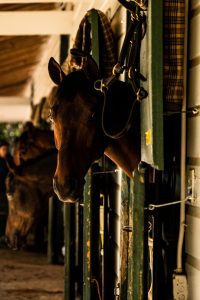 Thoroughbred – The breed of horse used in steeplechase racing. Every horse competing has documented lineage through the Jockey Club. Thoroughbreds are known for their speed, stamina, and athletic ability.
Thoroughbred – The breed of horse used in steeplechase racing. Every horse competing has documented lineage through the Jockey Club. Thoroughbreds are known for their speed, stamina, and athletic ability.
Flat Race – Traditional horse racing without jumps or obstacles, run on a flat oval track. Most Thoroughbreds start their careers in flat racing before some transition to steeplechase, which requires different skills and training.
Gelding – A castrated male horse. Many steeplechase horses are geldings continuing their racing careers.
Chaser – A horse that competes in steeplechase races. Someone might say “that’s a proven chaser” meaning the horse has a good track record.
Green – A horse that’s inexperienced or new to racing. Nothing to do with color—it means they’re still learning.
The People
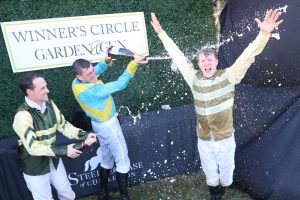 Jockey – The rider who guides the horse during the race. In steeplechase, jockeys weigh around 135 pounds minimum and must make split-second decisions while guiding the horse over obstacles.
Jockey – The rider who guides the horse during the race. In steeplechase, jockeys weigh around 135 pounds minimum and must make split-second decisions while guiding the horse over obstacles.
Trainer – The person responsible for preparing the horse for racing. They develop conditioning routines and decide which races to enter.
Owner – The person or group who owns the horse. The racing silks represent the owner, and they receive the prize money if their horse wins.
Groom – The person who cares for the horse daily through feeding, grooming, and monitoring health. They’re often the ones who know the horse best.
Steward – Race officials who ensure all rules are followed and make decisions about any incidents or protests during the race.
Pro Tips for Race Day
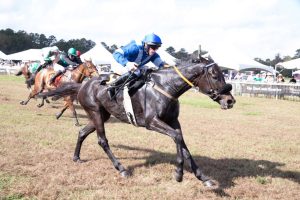 Now that you know the language, here’s how to use it. When horses parade in the paddock, look at their coat condition and how they’re moving. If someone asks who you like, you can say “the bay in the blue and white silks looks sharp” or “I’m watching how that chestnut takes the first fence.”
Now that you know the language, here’s how to use it. When horses parade in the paddock, look at their coat condition and how they’re moving. If someone asks who you like, you can say “the bay in the blue and white silks looks sharp” or “I’m watching how that chestnut takes the first fence.”
During the race, watch for horses making ground in the final stretch. That’s when steeplechase gets most exciting—tired horses, strategic jockeys, and one last fence to clear before the finish.
After the race, check the margin of victory. A win by several lengths means dominance. A photo finish means you just watched an incredible competition.
The best part? Even longtime racing fans learn something new at every event. The goal isn’t to be an expert—it’s to understand enough to appreciate the sport, follow the action, and maybe impress your friends with a well-timed “great take on that fence.”
Common Questions About Steeplechase Terms
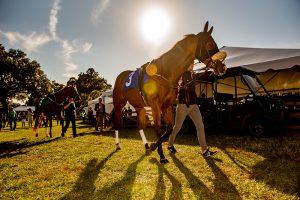 What does “going” mean in horse racing? Going refers to the track condition. Good going means firm, dry ground, while soft or heavy going indicates wet or muddy conditions that affect how horses run.
What does “going” mean in horse racing? Going refers to the track condition. Good going means firm, dry ground, while soft or heavy going indicates wet or muddy conditions that affect how horses run.
What is a photo finish in steeplechase? A photo finish occurs when horses cross the finish line so close together that officials must review camera footage to determine the winner.
What does “Riders Up” mean at a steeplechase? Riders Up is the call signaling jockeys to mount their horses in the paddock. It means the race is about to begin.
How are horses measured in racing? Horses are measured in “lengths,” with one length equaling roughly one horse’s body or about 8-10 feet. A win by two lengths means about 16-20 feet ahead.
What is a Thoroughbred horse? A Thoroughbred is a specific breed of horse with documented lineage through the Jockey Club. All steeplechase horses must be registered Thoroughbreds.
See you at Stono Ferry on November 9, 2025. You’ll sound like you’ve been going for years.










